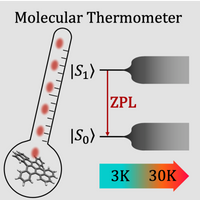Quantum Thermometry with Single Molecules in Nanoprobes
IF 11
Q1 PHYSICS, APPLIED
引用次数: 0
Abstract
An understanding of heat transport is relevant to developing efficient strategies for thermal management in areas of study such as microelectronics, as well as for fundamental science purposes. However, the measurement of temperatures in nanostructured environments and in cryogenic conditions remains a challenging task, requiring both high sensitivity and noninvasive approaches. Here, we present a portable nanothermometer based on a molecular two-level quantum system that operates in the (3–20)-K temperature range, with temperatures and spatial resolutions on the order of millikelvins and micrometers, respectively. We validate the performance of this molecular thermometer by estimating the thermal conductivity of a nanopatterned silicon membrane, where we find a quadratic temperature dependence. In addition, we demonstrate two-dimensional temperature mapping via the simultaneous spectroscopy of multiple probes deposited onto such a suspended membrane. Overall, these results demonstrate the unique potential of the proposed molecular thermometer to explore thermal properties with submicron accuracy and unveil related phenomena manifested at cryogenic temperatures.2 MoreReceived 22 February 2023Revised 3 July 2023Accepted 2 August 2023DOI:https://doi.org/10.1103/PRXQuantum.4.040314Published by the American Physical Society under the terms of the Creative Commons Attribution 4.0 International license. Further distribution of this work must maintain attribution to the author(s) and the published article's title, journal citation, and DOI.Published by the American Physical SocietyPhysics Subject Headings (PhySH)Research AreasAtomic & molecular processes in external fieldsMolecular spectraSpontaneous emissionAtomic, Molecular & Optical

单分子纳米探针的量子测温
对热传输的理解与开发诸如微电子学等研究领域的有效热管理策略以及基础科学目的相关。然而,在纳米结构环境和低温条件下的温度测量仍然是一项具有挑战性的任务,需要高灵敏度和非侵入性方法。在这里,我们提出了一种基于分子二能级量子系统的便携式纳米温度计,其工作温度范围为(3-20)k,温度和空间分辨率分别为毫开尔文和微米数量级。我们通过估计纳米图案硅膜的导热性来验证这种分子温度计的性能,在那里我们发现了二次温度依赖关系。此外,我们通过沉积在这种悬浮膜上的多个探针的同时光谱证明了二维温度映射。总的来说,这些结果证明了所提出的分子温度计在亚微米精度探索热性质和揭示低温下表现出的相关现象方面的独特潜力根据知识共享署名4.0国际许可协议,美国物理学会于2023年8月2日接受doi:https://doi.org/10.1103/PRXQuantum.4.040314Published。这项工作的进一步分发必须保持作者的归属和已发表文章的标题,期刊引用和DOI。发表于美国物理学会物理学科标题(PhySH)研究领域外场原子与分子过程分子光谱自发发射原子、分子与光学
本文章由计算机程序翻译,如有差异,请以英文原文为准。
求助全文
约1分钟内获得全文
求助全文

 求助内容:
求助内容: 应助结果提醒方式:
应助结果提醒方式:


